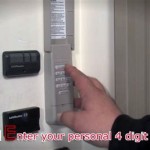How to Keep a Garage Door Open Manually
Garage doors are a significant convenience in modern life, providing secure access to vehicles and storage. However, situations can arise where the automated system fails, requiring manual operation. While opening a garage door manually is a relatively straightforward process, keeping it open for an extended period, especially when the opener is malfunctioning or there's a power outage, presents unique challenges. This article provides detailed instructions and considerations for safely and effectively keeping a garage door open manually.
Understanding the mechanics of a garage door system is crucial before attempting manual operation. A standard garage door operates using a system of springs (torsion or extension), cables, rollers, and tracks. The springs provide the counterbalancing force necessary to lift the heavy door with relative ease. The cables connect the springs to the bottom brackets of the door, transmitting the lifting force. Rollers guide the door along the tracks, ensuring smooth vertical movement. When the automated opener malfunctions, disengaging the opener and manually lifting the door relies on the integrity of this system, particularly the springs.
Before initiating any manual operation, safety should be the utmost priority. A garage door, especially a double-door, is a heavy object. A malfunctioning spring or cable can result in a sudden, uncontrolled descent, posing a significant safety risk. Therefore, it is advisable to inspect the entire system visually for any signs of damage or wear before proceeding. Specific attention should be paid to the condition of the springs, cables, and rollers. If any of these components appear damaged, frayed, or broken, it is strongly recommended to contact a qualified garage door technician for professional repair.
Disengaging the Automatic Opener
The first step in manually operating a garage door is to disengage it from the automatic opener. This is typically achieved by pulling the emergency release cord, a red handle dangling from the opener's track. This cord is connected to a trolley mechanism that links the opener to the door. Pulling the cord disconnects the trolley, allowing the door to be operated independently of the opener.
Prior to pulling the release cord, ensure the garage door is completely closed. If the door is partially open, disengaging the opener could cause the door to slam shut under its own weight, potentially causing damage or injury. If the door is stuck in a partially open position and cannot be safely closed, proceed with extreme caution and seek assistance from another person if possible. With the door closed, firmly pull the emergency release cord. This should disengage the trolley, and the door should now be able to be manually lifted.
It is important to note that some older garage door openers may have a different disengagement mechanism. Consult the owner's manual for specific instructions related to the model in question. If the release cord is difficult to pull or appears to be stuck, avoid excessive force, as this could damage the mechanism. Instead, try gently rocking the door back and forth while pulling the cord to relieve any tension on the trolley.
Manually Lifting and Securing the Door
Once the opener is disengaged, manually lift the garage door. Use both hands and lift from a comfortable position. Ideally, lift from the center of the door to distribute the weight evenly. If the door is properly balanced by the springs, it should lift with relative ease. If the door feels excessively heavy or difficult to lift, it indicates a potential problem with the spring system. Cease operation immediately and consult a garage door technician.
After lifting the door to the desired open position, it is critical to secure it to prevent it from accidentally closing. Relying solely on the springs to hold the door open is not a safe practice, as spring tension can weaken or fail unexpectedly. A common method for securing the door is to engage the trolley lock manually. After disengaging the opener, the trolley mechanism may have a lever or pin that can be manually engaged to lock the trolley in the open position. This will prevent the door from running down the tracks if the door begins to close. If it is not possible to engage the trolley lock, proceed to the next method.
A more secure method involves using clamps or locking pliers to secure the track above the top roller of the door. This creates a physical barrier that prevents the door from descending. Ensure the clamps are strong enough to withstand the weight of the door and are securely fastened to the track. Place the clamps on both sides of the track for added safety and stability. Regularly inspect the clamps to ensure they remain securely in place.
Another method involves using a sturdy piece of wood or metal, such as a 2x4 or a metal rod, to prop the door open. Position the prop vertically or diagonally between the floor and the bottom edge of the door, ensuring it is firmly in place. This provides additional support and prevents the door from closing. However, this method should be used with caution, as the prop could slip or be knocked out of place. Monitor the prop frequently to ensure it remains stable.
Considerations for Extended Periods
Leaving a garage door open manually for an extended period introduces additional considerations related to security, weather protection, and potential damage to the door system. Security is compromised when the automated locking mechanism is bypassed. The exposed garage provides an easier entry point for potential intruders. Implement additional security measures, such as installing temporary door locks or motion-activated lights, to deter unauthorized access.
Leaving the door open exposes the garage interior to the elements, including rain, wind, and extreme temperatures. This can damage stored items and create uncomfortable conditions inside the garage. If possible, cover or move sensitive items to a more protected area. Consider using tarpaulins or plastic sheeting to create a temporary barrier against the elements.
Prolonged manual operation can place additional stress on the garage door system, particularly the springs and cables. If the springs are weakened or damaged, the door may become increasingly difficult to lift and could eventually fail completely. Regularly inspect the spring system for signs of wear or damage. If any problems are detected, contact a qualified technician for repair or replacement. Additionally, consider the long-term impact on the opener itself. Repeated disengagement and re-engagement of the trolley mechanism can cause wear and tear, potentially shortening the lifespan of the opener. If the opener is malfunctioning, consider professional repair or replacement rather than relying solely on manual operation for an extended period.
Finally, remember to re-engage the automatic opener once the issue is resolved. To do this, pull the emergency release cord again to release the trolley lock (if engaged). Then, operate the garage door opener using the wall button or remote. The trolley should automatically re-engage with the chain or belt drive. If the trolley does not re-engage, consult the opener's manual or contact a professional technician for assistance.

How To Manually Open Close Your Garage Door Step By

Power Outage Here S How To Open Your Garage Door A All Style

How To Open A Garage Door Manually From The Outside Inside

How To Release And Reset The Emergency Cord On A Garage Door

How To Open A Garage Door Manually

How To Open A Garage Door Manually

Pro Tip How To Operate A Garage Door Manually

How To Manually Open Close Your Garage Door Step By

How To Open A Garage Door Manually From The Outside Inside

How To Open A Locked Garage Door From The Outside Without Key Mesa Doors
Related Posts








